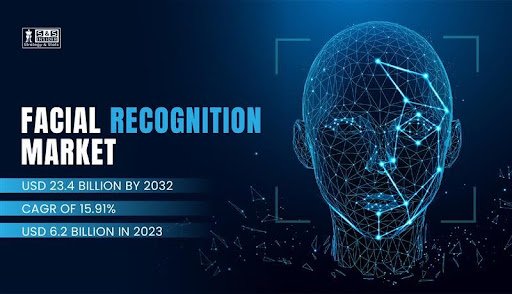Facial recognition technology has rapidly evolved from a futuristic concept to a mainstream solution across various sectors. With its ability to identify individuals in real time and enhance security, streamline operations, and improve customer experiences, the Facial Recognition Market has become a focal point for investors, governments, and businesses alike. Adoption spans across security & surveillance, banking & finance, retail, healthcare, and transportation industries, making it a transformative force in the digital era.
Facial Recognition Market Size and Growth Forecast
As per the SNS Insider, The Facial Recognition Market Size stood at USD 6.2 billion in 2023 and is projected to surge to USD 23.4 billion by 2032, reflecting a robust CAGR of 15.91% over the forecast period from 2024 to 2032. This growth is propelled by increasing demand for advanced security systems, the rise of smart cities, and the adoption of AI-enabled technologies. Industries are leveraging facial recognition for enhanced fraud detection, access control, and personalized services, contributing significantly to market expansion. Furthermore, advancements in deep learning algorithms and cloud computing have made the technology more scalable and cost-effective, driving broader adoption.
Key Drivers Shaping the Facial Recognition Market
Several factors are fueling the rapid expansion of the Facial Recognition Market. The rising need for heightened security in public and private spaces has prompted governments and enterprises to integrate facial recognition systems into surveillance networks. Additionally, the growth of digital payment systems and biometric authentication solutions in banking and finance sectors is driving demand. The retail industry is also capitalizing on facial recognition to offer personalized marketing and improve in-store experiences, while healthcare institutions are deploying the technology to enhance patient management and safety. Technological innovations such as 3D facial recognition, infrared cameras, and AI-driven analytics are further strengthening market adoption.
Challenges in the Facial Recognition Market
Despite the significant opportunities, the Facial Recognition Market faces certain challenges that could impede growth. Privacy concerns and regulatory compliance issues remain major hurdles, as misuse of personal biometric data can lead to reputational and legal consequences. Additionally, the high cost of deploying advanced facial recognition systems can be prohibitive for small and medium-sized enterprises. Accuracy limitations in uncontrolled environments, such as poor lighting or occlusions, also pose technical challenges that require continuous innovation and algorithm improvements.
Opportunities in the Facial Recognition Market
The Facial Recognition Market presents numerous growth opportunities, particularly through integration with emerging technologies. Combining facial recognition with AI and IoT opens avenues for smarter surveillance, automated customer insights, and predictive analytics. Expanding applications in smart homes, autonomous vehicles, and border security can further increase market penetration. Additionally, growing adoption in emerging markets such as Asia-Pacific and Latin America presents significant potential due to increasing digital infrastructure and government investments in safety and security measures.
Regional Insights: Global Footprint of the Facial Recognition Market
The Facial Recognition Market is witnessing varied growth trends across regions. North America dominates due to extensive technology adoption, high investment in security solutions, and strong government regulations. Europe follows closely, with increased use in public safety and retail sectors. Meanwhile, Asia-Pacific is emerging as the fastest-growing region, driven by rapid urbanization, smart city initiatives, and rising demand for surveillance and banking solutions in countries like China, India, and Japan. Latin America and the Middle East & Africa are also showing promising growth prospects as businesses and governments increasingly invest in biometric security solutions.
Future Outlook and Trends in the Facial Recognition Market
The Facial Recognition Market is expected to continue its upward trajectory as technology becomes more sophisticated and widely accepted. The convergence of AI, cloud computing, and advanced analytics will enhance accuracy, reduce costs, and expand applications across industries. Additionally, regulatory frameworks aimed at addressing privacy concerns will provide clarity and build consumer trust, further encouraging adoption. Companies focusing on innovative solutions, partnerships, and regional expansion are likely to lead the market in the coming years.
FAQs about the Facial Recognition Market
Q1: What is the CAGR of the Facial Recognition Market from 2024 to 2032?
A1: The Facial Recognition Market is projected to grow at a CAGR of 15.91% during the forecast period from 2024 to 2032, driven by increased demand for biometric security solutions and technological advancements.
Q2: What is the forecast for the Facial Recognition Market size by 2032?
A2: The market size is expected to reach USD 23.4 billion by 2032, up from USD 6.2 billion in 2023, indicating strong growth potential across multiple industry applications.
Q3: Which region is expected to experience the highest growth in the Facial Recognition Market?
A3: Asia-Pacific is anticipated to witness the fastest growth due to rising smart city initiatives, urbanization, and increasing investments in security and digital infrastructure in countries like China, India, and Japan.










